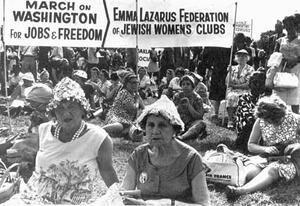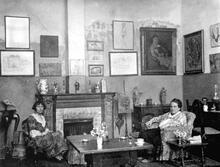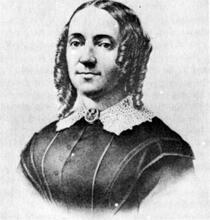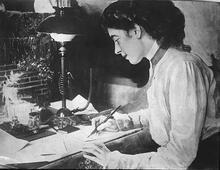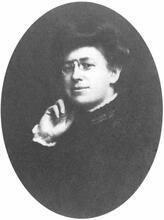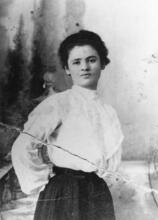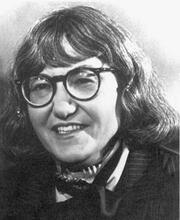Emma Lazarus Federation of Jewish Women's Clubs
The Emma Lazarus Federation was committed to a wide variety of progressive causes, springing from the members' belief in and dedication to their own identification as Jews, as women, as workers and as Americans.
Institution: The Jacob Rader Marcus Center of the American Jewish Archives, Cincinnati, OH, www.americanjewisharchives.org and the New York Herald Tribune; Photograph by Ira Rosenberg.
Starting as a division of the larger International Workers Order, the Emma Lazarus Federation of Jewish Women’s Clubs (ELF) reorganized independently in 1951 after its parent organization faced legal action from the New York State attorney general for allegedly being a "subversive" institution. ELF held onto to its radical tradition and embraced a progressive, secular Jewish heritage, as exemplified by the life and work of poet Emma Lazarus. It aimed to give leadership to women in Jewish communities, as well as promote, through education and outreach, a variety of broader causes, including progressive organization, women's rights, civil rights, the end of antisemitism and racism, support for the State of Israel, world peace, and consumers’ issues. The Federation disbanded in 1989.
Beginnings
The Emma Lazarus Federation of Jewish Women’s Clubs (ELF), a progressive women’s group, grew out of the Emma Lazarus Division, founded in 1944 by the Women’s Division of the Jewish People’s Fraternal Order of the International Workers Order (IWO). Formed to provide relief to wartime victims, but especially to combat antisemitism and racism and to nurture positive Jewish identification through a broad program of Jewish education and women’s rights, the Emma Lazarus Division attracted a membership of leftist, largely Yiddish-speaking women, many of the immigrant generation. Among its founders was Clara Lemlich Shavelson, the young woman who had called for the general strike of garment workers that sparked the 1909 Uprising of the 20,000. Shavelson and other organizers believed that, because of the Holocaust, thousands of women had become “newly aware of themselves as Jewish women,” but they urgently needed “history, self-knowledge as Jews, and cultural products” that could sustain the fight against fascism. In its early years, the division offered fellowships for fiction and history on Jewish themes. It also supported a home for French war orphans and a day nursery in Israel and championed a broad range of women’s issues.
Founding
In 1951, after the New York State attorney general initiated proceedings against the IWO as a subversive institution, the division reorganized as the independent Emma Lazarus Federation of Jewish Women’s Clubs. Although some leaders broke with the Communist Party, the ELF did not relinquish its radical commitments. Throughout the 1950s, the ELF emphasized the progressive voice of labor as the hallmark of democracy and called for coexistence with the Soviet Union. While Khrushchev’s revelations about Stalinist terrors and other information about the country’s virulent antisemitism shocked the ELF, leaders like the executive directors, June Croll Gordon and Rose Reynes (who became director after Gordon’s death), continued to hope that the USSR would not discriminate against Jews and other ethnic minorities.
The Spirit of Emma Lazarus
The terrors of McCarthyism, which stigmatized many Jewish radicals as “un-American” communists, contributed to the Emmas’ desire to claim their own Jewish identity by promoting a progressive, secular Jewish heritage. In the early 1950s, the ELF focused attention on two Jewish women whose achievements they believed symbolized two different directions. The ELF commissioned Eve Merriam to write a biography of poet and essayist Emma Lazarus. For the ELF, Lazarus’s “universal scope,” coupled with her support for Jewish culture and women’s freedom, made her an admirable symbol of secular, humanistic values. Every year, the Emmas celebrated Lazarus’s birthday with a trip to Liberty Island. They succeeded in having the cities of New York and Miami declare an Emma Lazarus Day and arranged a commemorative medal to honor her. Basing their program on Lazarus’s work, the Emmas hoped to give “leadership to women in Jewish communities in our own time in the same spirit as Emma Lazarus did in hers.”
The Club's Works
In 1954, the ELF published a biography of Ernestine Rose by Yuri Suhl. Although Rose’s work as social reformer, abolitionist, and suffragist was not Jewish-oriented, the ELF claimed her as the first Jewish woman reformer in the United States. To the ELF, Rose’s work on behalf of abolition and women’s rights and against antisemitism demonstrated the “interrelationships between Jew and non-Jew, Negro and white, men and women.” Like Lazarus, she was seen to combine Jewish patriotism with a broader humanism.
The ELF also wrote outlines of Rebecca Gratz, Lillian D. Wald, Sophie Loeb, and Penina Moïse. Interested in the broader history of American women, it developed curricula on the contributions of dissident women from Anne Hutchinson to Ethel Rosenberg, and on the role of America’s working women in the Lowell mills and garment sweatshops. In 1954, it commissioned artist Philip Reisman to do a mural of the 1909 mass meeting at Cooper Union, depicting Clara Lemlich at the center. The five-by-seven-foot painting was donated to the International Ladies Garment Workers Union in 1982. The ELF also commemorated the anniversary of the uprising of the Warsaw Ghetto, paying tribute to the women who took part in the antifascist resistance, as well as those who helped establish the State of Israel.
Ideals and Outreach
The links between women’s rights and the abolitionist and civil rights movements was of special interest. The ELF wrote about such black women leaders as Sojourner Truth, Ida B. Wells, Harriet Tubman, Frances Ellen Harper, Rosa Parks, and Autherine Lucy. Its most important contribution was the pamphlet “Women in the Life and Time of Abraham Lincoln,” a reprint of the proceedings of a conference held by the National Women’s Loyal League in 1863, with an introduction by Daisy Bates, leader of the desegregation struggle at Little Rock High School.
In 1951, the ELF joined in a statement of principle with the Sojourners for Truth and Justice, a black women’s group. The Emmas made a regular financial contribution to the Sojourners, and the groups met at an annual luncheon. During the 1950s and 1960s, the ELF sent truckloads of food and clothing to the South and joined boycotts and sit-ins. In 1963, the ELF initiated a multiyear petition campaign for the United States to ratify the Genocide Convention, which had been adopted by the UN General Assembly in 1948 and subsequently signed by seventy-five nations; it considered this campaign its most important political project.
The ELF five-point program, adopted in 1951, established lasting goals. While the promotion of Jewish culture was considered the “number one project,” other goals included the elimination of antisemitism and racism, the campaign for women’s rights, support for the State of Israel, and world peace and consumers’ issues. The ELF tracked and protested the resurgence of neo-Nazism throughout the United States and abroad (its blind spot remained the public disregard of Soviet antisemitism), continued as the sole support of the day-care center it had established for the Jewish and Arab children of working mothers in Israel, engaged in a vigorous campaign for a statute of limitation against the deportation of foreign-born Americans, became a cofounder of the Museum of Immigration on Liberty Island, and supported numerous peace efforts and organizations.
Women’s issues were always central to ELF interest. It worked continuously to bring women’s history, especially Jewish women’s history, to a wide public. After the advent of second-wave feminism in the 1960s, the ELF joined women’s rights organizations to support the Equal Rights Amendment and advocated for working women’s and minority women’s interests.
Legacy
With chapters in Brooklyn, the Bronx, Boston, Los Angeles, San Francisco, Chicago, Philadelphia, Detroit, Miami, Rochester, Newark, Jersey City, Lakewood, and Toms River, New Jersey, the ELF maintained its educational and political activities for almost forty years, attracting approximately 4,000 to 5,000 members in 100 clubs at its peak. Affected by the graying of the membership, the transformation of women’s work, and the development of the women’s movement, the Emma Lazarus Federation of Jewish Women’s Clubs disbanded in 1989, though some individual clubs remained. It had been, according to its leaders, the “only Jewish women’s organization that encourages mass action, the movement of people,” a “progressive organization.”
While all of its varied projects sprang from a dedicated core of Jewish identity, members’ pride in their ethnicity did not hamper, but in fact promoted, their identification as women, workers, and Americans. As proclaimed in the ELF’s 1951 constitution, the enhancement of Jewish culture was proposed “as a part of the whole multi-national culture of American life.” “We are a part of American life generally, and of the Jewish community in particular,” one ELF president reaffirmed, as well as a member of the “family” of women’s organizations. In this manner, the Emmas asserted the importance both of “unity as Jews, unity in variety” and the “special approach” needed to solve women’s problems.
Antler, Joyce. “Between Culture and Politics: The Emma Lazarus Federation of Jewish Women’s Clubs and the Promulgation of Women’s History, 1944–1989.” In U.S. History as Women’s History: New Feminist Essays, edited by Linda K. Kerber, Alice Kessler-Harris, and Kathryn Kish Sklar (1995).
Emma Lazarus Federation of Jewish Women Clubs. Papers. American Jewish Archives, Cincinnati, Ohio.

